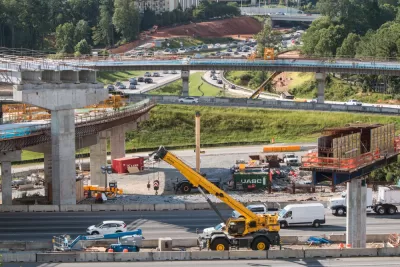How complicated zoning and permitting, slow construction, and a dearth of certain skills in the public sector cause delays and increase the cost of U.S. infrastructure projects.

"It is one thing to fill potholes; another to fundamentally change the way we do business," writes architect Moshe Safdie about the recently passed federal infrastructure bill. Will the $1.2-billion investment actually improve our obsolete and outdated infrastructure, or just fund studies that will leave implementation to the future?
According to Safdie, the U.S. faces three challenges to its capability to push forward major infrastructure projects. The first is our "convoluted" permitting, zoning, and community input process, which can cause major delays and cost increases. Safdie calls for a more centralized authority that would counterbalance local concerns with broader goals.
A second challenge facing U.S. infrastructure is the glacial speed of construction, which drains both funding and public support for seemingly endless projects. In other countries, writes Safdie, construction projects use multiple shifts to operate around the clock and pre-fabricated parts to speed up construction and reduce disruption to neighbors.
The third major obstacle, in Safdie's view, is a lack of "conceptual and engineering creativity" in the U.S. public sector. Safdie recommends boosting public-private partnerships like the 1990s-era Design Excellence Program or the COVID-19 vaccine development effort, which harnessed public resources and private skills to design and implement public projects quickly and effectively.
FULL STORY: Can the U.S. Build Big Again?

Trump Administration Could Effectively End Housing Voucher Program
Federal officials are eyeing major cuts to the Section 8 program that helps millions of low-income households pay rent.

Planetizen Federal Action Tracker
A weekly monitor of how Trump’s orders and actions are impacting planners and planning in America.

Ken Jennings Launches Transit Web Series
The Jeopardy champ wants you to ride public transit.

Why Bike Lanes Are Good: An Explainer for the US Transportation Secretary
Sean Duffy says there’s no evidence that bike lanes have benefits. Streetsblog — and federal agencies’ own data — beg to differ.

California Invests Additional $5M in Electric School Buses
The state wants to electrify all of its school bus fleets by 2035.

Austin Launches $2M Homelessness Prevention Fund
A new grant program from the city’s Homeless Strategy Office will fund rental assistance and supportive services.
Urban Design for Planners 1: Software Tools
This six-course series explores essential urban design concepts using open source software and equips planners with the tools they need to participate fully in the urban design process.
Planning for Universal Design
Learn the tools for implementing Universal Design in planning regulations.
Ada County Highway District
Clanton & Associates, Inc.
Jessamine County Fiscal Court
Institute for Housing and Urban Development Studies (IHS)
City of Grandview
Harvard GSD Executive Education
Toledo-Lucas County Plan Commissions
Salt Lake City
NYU Wagner Graduate School of Public Service





























